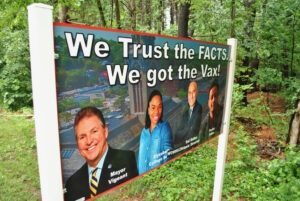Hudson, Marlborough meeting state averages for fully-vaccinated residents
By Stuart Foster, Contributing Writer

REGION – As some neighboring communities soar ahead of the state average, Marlborough and Hudson are still keeping pace in the ongoing push to vaccinate as many residents as possible against COVID-19, state data shows.
As of June 29, Hudson, Marlborough, Grafton and Shrewsbury all had similar rates, with 69 percent, 67 percent, 66 percent and 71 percent of residents, respectively, being fully vaccinated. In Northborough, Southborough and Westborough the rates were, in order, 87 percent, 84 percent and 87 percent.
The trend persisted in data tracking residents with at least one dose.
While the first four municipalities were close to state averages, Northborough, Southborough and Westborough’s rates were significantly higher.
Marlborough Public Health Director John Garside attributed the differences in vaccination rates among neighboring towns, in part, to demographics.
“I think, first and foremost, it’s social and economic status,” he said in a recent interview.
Addressing his city’s effort, Garside said that the Board of Health has continually worked to inform people about vaccines. Efforts include putting information on signs and banners featuring prominent city figures, creating t-shirts and wristbands encouraging vaccination and releasing brochures identifying where and when to get vaccinated.
State outreach influences local action
When the Massachusetts Department of Public Health (DPH) began investing resources directly into 20 underserved communities disproportionately impacted by COVID-19, Marlborough was not on the list. However, Garside said that some of the DPH’s solutions, particularly the use of vaccine ambassadors, influenced Marlborough’s approach.
“We take some ideas from there, but we certainly have our own ideas, such as signage and banners,” Garside said.
Marlborough now has three bilingual ambassadors. Two speak Spanish while the other speaks Portuguese. Together, they have worked to connect with Latino and Hispanic communities in Marlborough.
Garside said that Marlborough’s response was also helped by weekly meetings of its Emergency Management Group throughout the pandemic, with the Police Department, Fire Department and Department of Public Works helping with masks, a food pantry and electronic messaging.
He mentioned that the Marlborough Hospital, with which the Board of Health had weekly meetings, was also a tremendous resource, particularly in providing vaccinations at the Marriott hotel.
Garside added that the School Department was extremely helpful in translating information about vaccinations.
“They really offered us access to their translators, and that’s been a great resource even up until today,” he said.
There has also been collaboration with other municipalities on efforts like a first responder clinic with neighboring Hudson.
Officials eye next steps in prolonged vaccination effort
Moving forward, Garside said that reaching people hesitant to take the vaccine is a priority. He added that the most effective examples helping dispel myths come when an individual’s friends and family members become vaccinated.
“I always use the argument or example that, when I got [my vaccine], you feel like you can do a few more things,” Garside said. “You think less about it when you’re out and about.”
Learn more about Marlborough’s COVID-19 response by visiting https://www.marlborough-ma.gov/ and clicking the red COVID-19 banner on the homepage.












